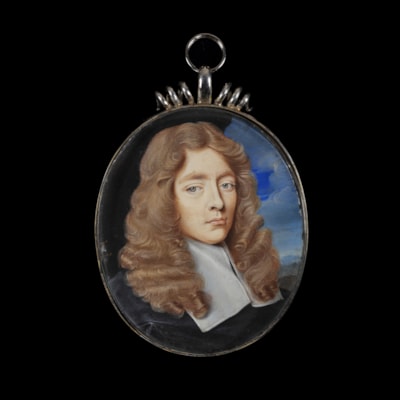ISAAC OLIVER
(c.1565-1617)Portrait miniature of a Nobleman wearing a black doublet with an embroidered pink sash, a rebato collar with scalloped lace edging, and a large gem stone earring; his hair in a ‘lovelock’ on his left; a gold sunburst over his right shoulder
1610s
Watercolour on parchment, laid on card in later gold frame with engraved reverse and pierced spiral cresting
Inscribed ‘J’eclaircirà[i]’ (‘I will brighten’)
Oval, 41 mm (1 ⁵/₈ inches) high
SOLD
Though the sitter of this portrait remains unidentified, the timing of its creation and observations of features of the composition suggest that he would have been part of the Jacobean court. This is suggested by elements of his dress; such a large, lace collar and black silk doublet would have allowed the sitter to fit in with the fashion of the court at this time. Two features in the right side of the composition also reveal facts about the nobleman. The lock of hair that falls down towards his shoulder was known as a ‘lovelock’, and was used to signify that the sitter was loyal to a loved one. This was something featured in other portraits by Oliver, including an even larger example in a miniature of Thomas Fones[1]. Also, what now appears to be a black gem set into an earring would have at the time been a diamond, painted in silver, that has since oxidised.
The present miniature features other elements that can be recognised in other works by Oliver, which may have formed part of the reason for its recent reattribution. For example, the brilliantly decorated and embroidered sash worn by the nobleman bears a resemblance to that worn by an unknown gentleman in a miniature sold at Christie’s in 2019[2], and to the larger sash worn by Henry, Prince of Wales, in a miniature in the Fitzwilliam Museum, Cambridge[3]. Sashes like this were commonly used to identify positions in the military, so it is possible that our sitter was also a military man.
The inscription in a stunningly maintained gold pigment that can be found to the sitter’s right translates to ‘I will brighten’, which links to the sunburst that has been illustrated next to it. An impresa like this would have traditionally been related to the sitter, however, as he remains unidentified, in this case we do not know in which way this related. It may be that this was meant to remind the owner of the miniature of who they were looking at. Given that there are other tokens of love featured here, like the lovelock, this owner could have been a loved one of the gentleman depicted.
[1] Sold Cheffins, 28/29 November 2018, lot 161.
[2] London, Christie’s, 13 November 2019, lot 161.
[3] Isaac Oliver, Miniature of Henry Frederick, Prince of Wales, Fitzwilliam Museum, Cambridge, 3903.
Christie’s, London, ‘Fine Portrait Miniatures’, 20 March 1990, lot 153 (sold as by Hilliard);
Sotheby’s London, ‘Important Silver, Objects of Vertu, and Portrait Miniatures’, 9 November 1995, lot 28 (sold as by Hilliard);
Private Collection.
Philip Mould & Company, London, 2019, Jewel in the Hand:
Early Portrait Miniatures from Noble & Private Collections, cat no. 20, ill. p.86;
E. Rutherford;
L. Henrdra (Eds), Philip Mould & Company, London, 2021, Love’s Labour’s Found, cat.no 16, ill. p.91, p.93.
Early Portrait Miniatures from Noble & Private Collections, 12th March - 18th April 2019, cat no. 20;
Philip Mould & Company, London, Love’s Labour’s Found, 21 April-28 May 2021, cat.no 16.

shipping notice
Worldwide shipping is included in all prices.
The Limner Company does not accept any responsibility for import duty, this is to be paid by the buyer.
Some stock items contain materials from endangered species which are governed by CITES regulations and will require a permit to export outside of Great Britain. If a certificate of export is required then this will be the responsibility of and paid for by the buyer .
you may also like













